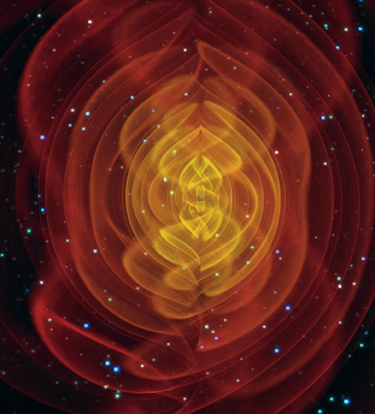When black holes collide, they cause surrounding space-time to wiggle, generating a torrent of radiation known as gravitational waves. That’s what Einstein’s general theory of relativity predicts, but computer models have struggled for more than 30 years to reproduce those waves. Because of the relativity theory’s mathematical complexity and the extreme gravity of black holes, modelers hadn’t succeeded in getting black holes to crash. Instead, the computer programs did.

Now, two teams independently report that they have successfully simulated the merger of two black holes and the event’s production of gravitational waves.
“This is a breakthrough not only in numerical relativity, but it is a necessary step in preparing us to observe gravity waves,” comments theorist Stuart Shapiro of the University of Illinois at Urbana-Champaign. “It’s also the first serious link between cosmology and the merger of black holes.”
Observers have begun searches for gravitational waves using several ground-based networks (SN: 1/8/00, p. 26: Available to subscribers at Catch a Wave). A space-based detector is scheduled for launch early in the next decade. The waves described by the new simulations “are telling the detectors what to look for,” says Carlos Lousto of the University of Texas at Brownsville.
Lousto and his colleagues, as well as a group led by John Baker and Joan Centrella of NASA’s Goddard Space Flight Center in Greenbelt, Md., describe some of their work in the March 24 Physical Review Letters. Both groups also report new simulations in an upcoming Physical Review D.
Modelers had previously simulated gravitational waves produced by colliding neutron stars, which are city-size balls of neutrons. But colliding black holes presented more of a problem. The gravity of such a monstrous pair squeezes space-time to a point that has infinite density, the so-called singularity that a computer program has difficulty handling.
Some researchers, including the teams led by Baker and Lousto, deal with the singularity by isolating it “into a corner of the computer grid never seen by the computer code,” explains Shapiro. “Most people who might have thought about this method were afraid to try it,” he says. That strategy seemed destined to fail, says Shapiro, because people thought, “you can run [from a singularity], but you can’t hide.”
Nevertheless, the simple approach enabled the modelers to watch the gravitational waves emitted by two orbiting, equal-mass black holes in the critical period hours or seconds before they coalesced.
Newer work by the Goddard team focuses on black hole collisions in which one of the bodies is heavier than the other. In such unequal-mass collisions, gravitational waves are concentrated in a specific direction, propelling the merged body in the opposite direction.
Such kicks might have played a crucial role in the growth of supermassive black holes when the universe was about half a billion years old. The center of nearly every new galaxy back then probably housed a fledgling black hole. Collisions between two unequal-size black holes could have generated a gravitational-wave kick big enough to eject each member of the pair from its home galaxy, making unlikely any further growth of those black holes or their galaxies.
The strength of the kick revealed by the Goddard simulation suggests that gravitational waves could indeed have controlled the growth of black holes and galaxies.
The findings shed light “on a huge cosmological problem of how … supermassive black holes in galaxies grow into bigger ones,” says Shapiro.







